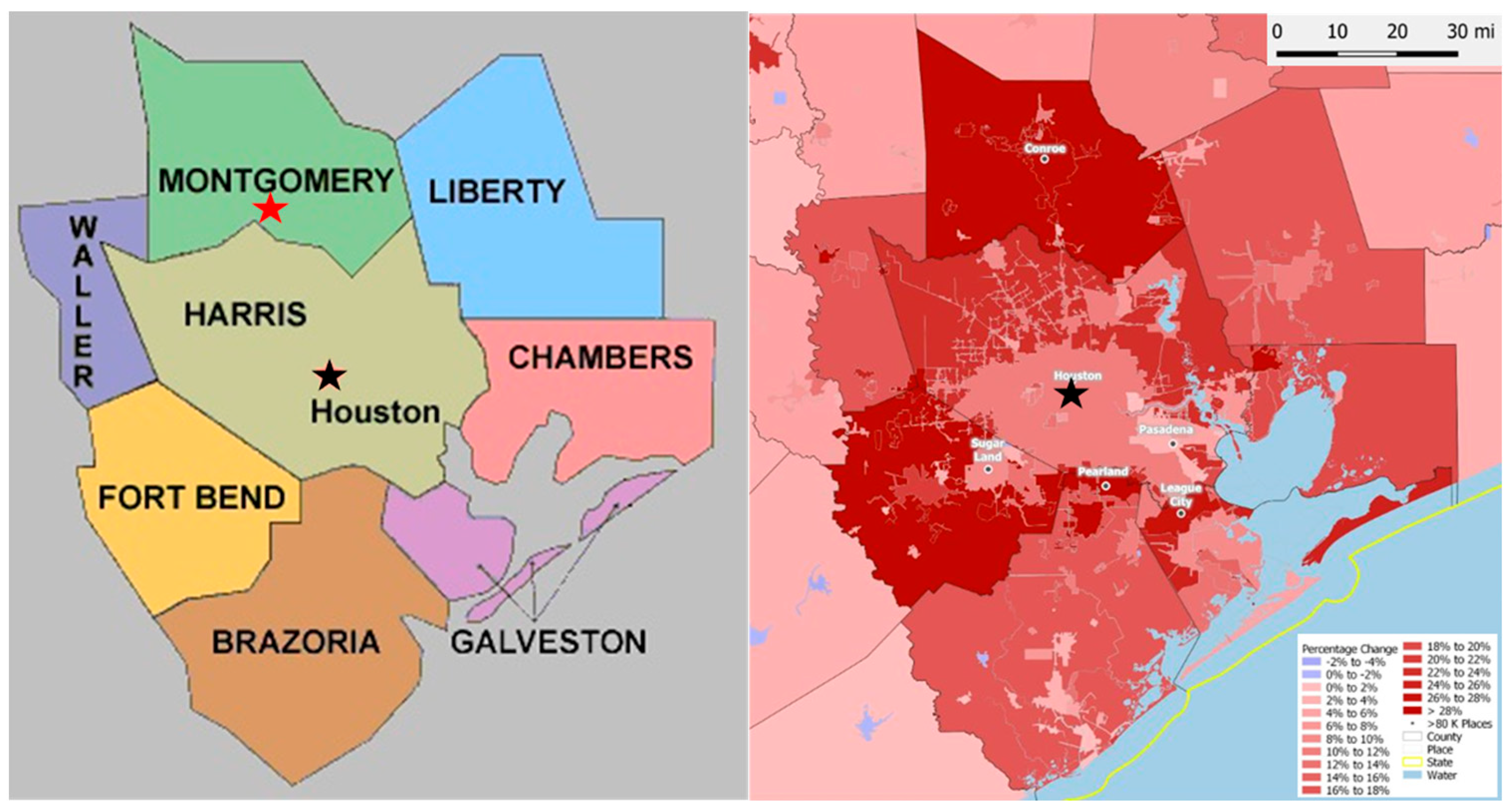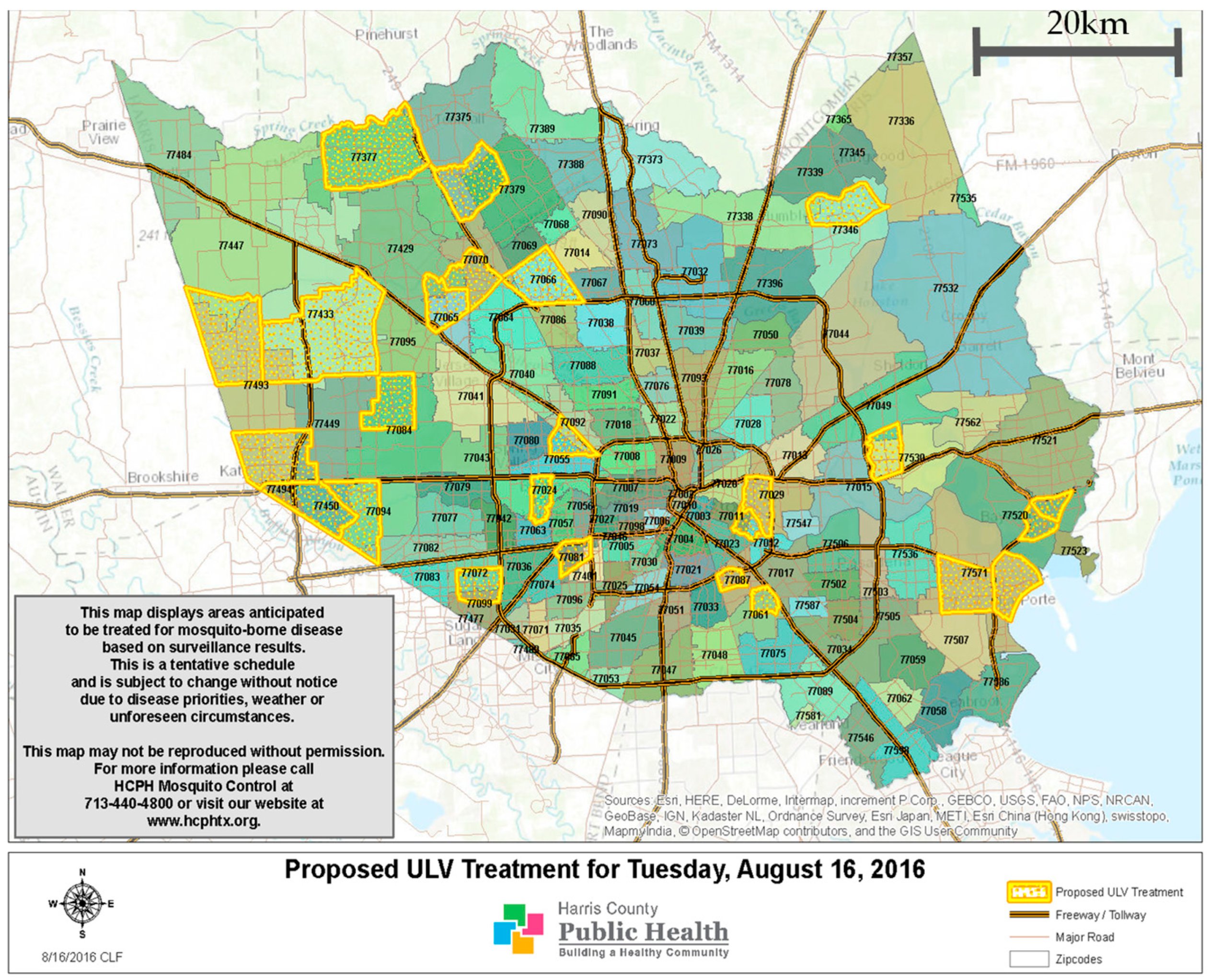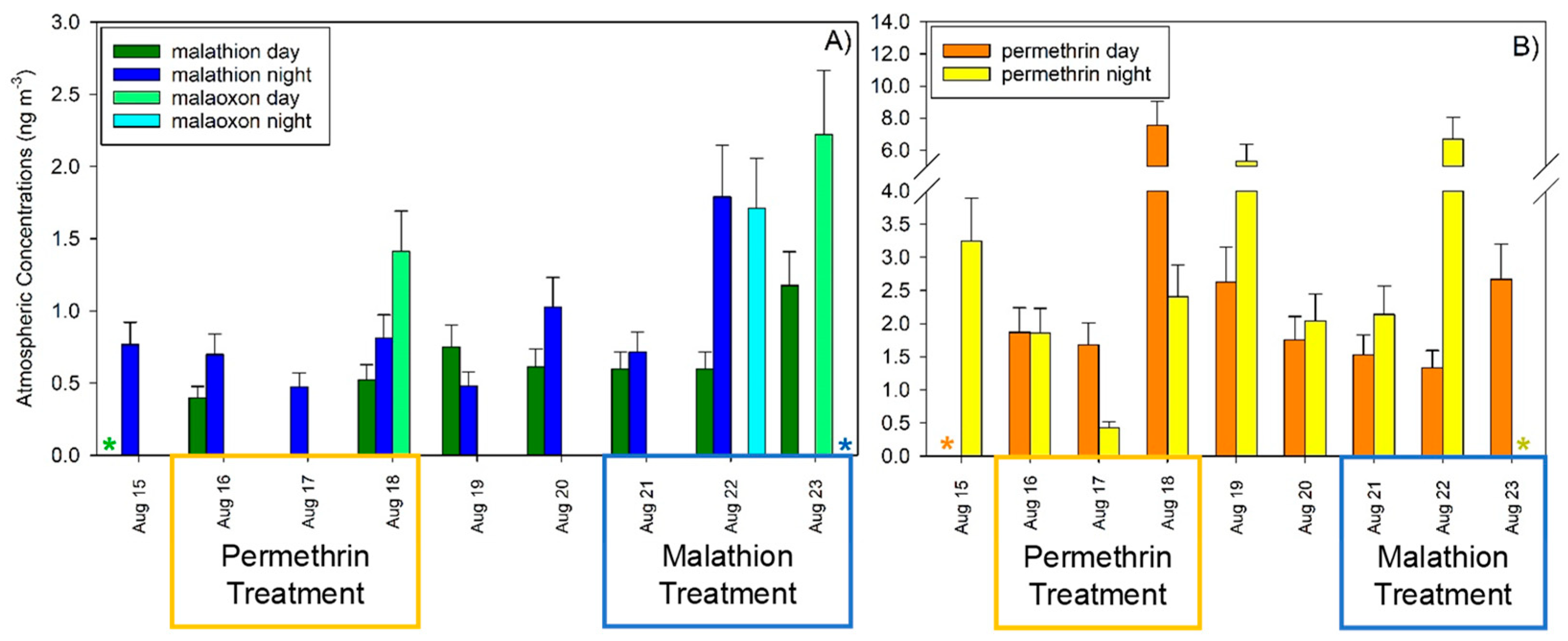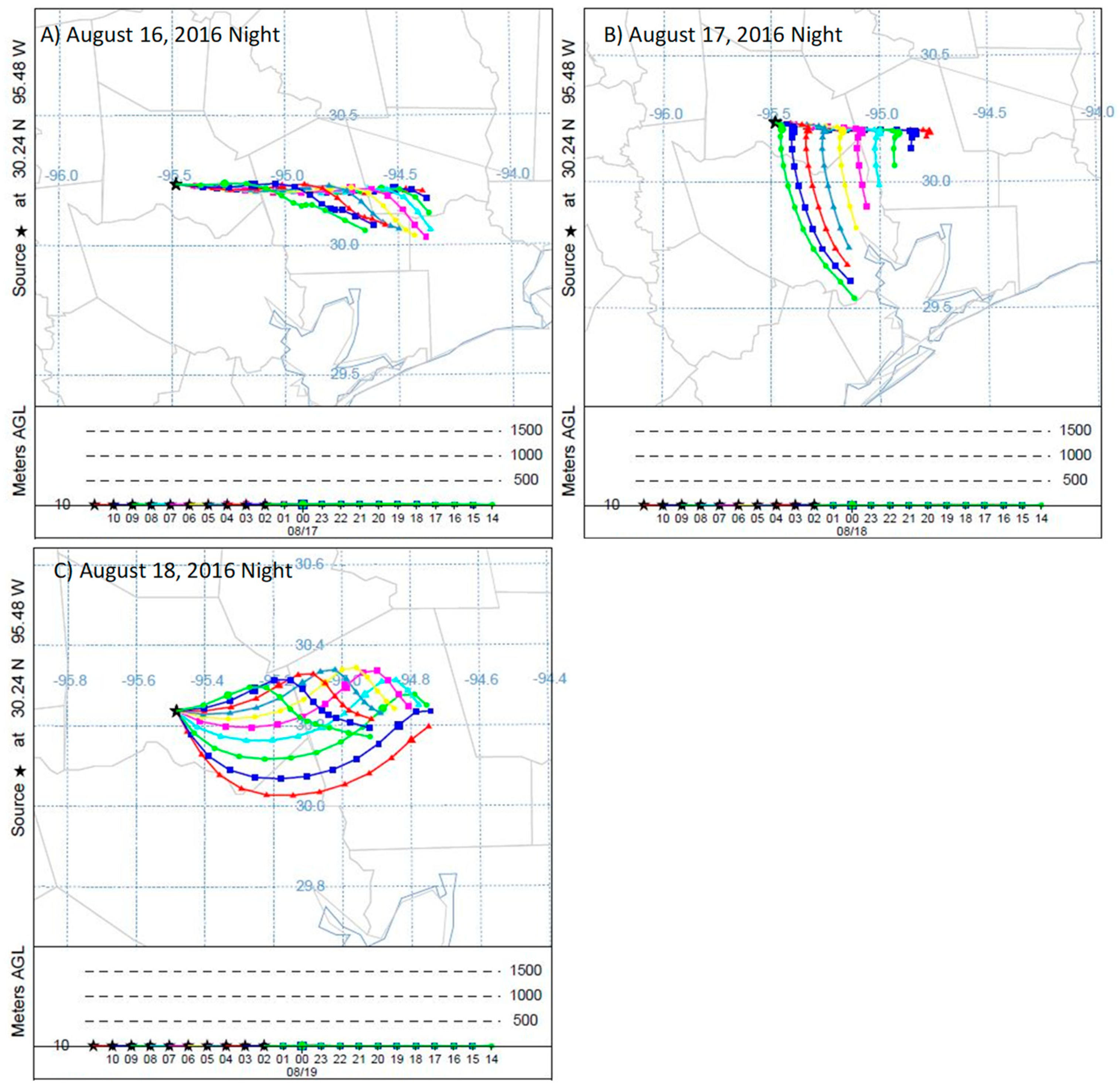Atmospheric Transport of Adulticides Used to Control Mosquito Populations across an Urban Metropolitan Area
Abstract
:1. Introduction
2. Materials and Methods
2.1. Sampling
2.2. NOAA HYSPLIT Trajectory Model
2.3. Chemicals and Consumables
2.4. Chemical Analysis
2.5. Quality Assurance/Quality Control
3. Results and Discussion
3.1. Malathion and Malaoxon
3.2. Permethrin
4. Conclusions
Supplementary Materials
Author Contributions
Funding
Data Availability Statement
Acknowledgments
Conflicts of Interest
References
- Helmer, J. 6 Mosquito Diseases That Can Be Deadly; Pfizer: New York, NY, USA, 2016. [Google Scholar]
- AMCA. The American Mosquito Control Association. Available online: https://www.mosquito.org/default.aspx (accessed on 3 March 2023).
- WHO. Mosquito-Borne Diseases. Available online: https://www.who.int/neglected_diseases/vector_ecology/mosquito-borne-diseases/en/ (accessed on 31 July 2023).
- WHO. Dengue and Severe Dengue; World Health Organization: Geneva, Switzerland, 2023. [Google Scholar]
- Gatto, M.P.; Cabella, R.; Gherardi, M. Climate change: The potential impact on occupational exposure to pesticides. Ann. Istituto Super. Sanita 2016, 52, 374–385. [Google Scholar]
- Reiter, P. Climate change and mosquito-borne disease. Environ. Health Perspect. 2001, 109 (Suppl. S1), 141–161. [Google Scholar] [PubMed]
- Tang, C.; Davis, K.E.; Delmer, C.; Yang, D.; Wills, M.A. Elevated atmospheric CO2 promoted speciation in mosquitoes (Diptera, Culicidae). Commun. Biol. 2018, 1, 182. [Google Scholar] [CrossRef] [PubMed]
- Rother, H.-A.; John, J.; Wright, C.Y.; Irlam, J.; Oosthuizen, R.; Garland, R.M. Perceptions of Occupational Heat, Sun Exposure, and Health Risk Prevention: A Qualitative Study of Forestry Workers in South Africa. Atmosphere 2020, 11, 37. [Google Scholar] [CrossRef]
- Van den Berg, H.; da Silva Bezerra, H.S.; Al-Eryani, S.; Chanda, E.; Nagpal, B.N.; Knox, T.B.; Velayudhan, R.; Yadav, R.S. Recent trends in global insecticide use for disease vector control and potential implications for resistance management. Sci. Rep. 2021, 11, 23867. [Google Scholar] [CrossRef]
- Harris County Public Health. Available online: http://publichealth.harriscountytx.gov/Services-Programs/All-Services/Mosquito-Control-Services (accessed on 23 August 2016).
- Public Health Pesticides. Available online: https://www.glamosquito.org/public-health-pesticides (accessed on 31 July 2023).
- Environmental Stewardship Mosquito Control. Available online: https://westchicago.org/environmental-stewardship/mosquito-control/ (accessed on 31 July 2023).
- Truck Mosquito Spraying. Available online: https://www.miamidade.gov/global/solidwaste/mosquito/truck-spraying.page (accessed on 31 July 2023).
- Kim, Y. The Mosquito Trucks of Childhood Past: Where Are They Now; Korea Expose: Seoul, Republic of Korea, 2017. [Google Scholar]
- Pest-Control Measures Ramped Up to Ensure Clean and Safe CIIE Venues; Shanghai Municipal People’s Government: Shanghai, China, 2022.
- Peru: Rise in mosquito populations in Lima. Crisis24. 2017. Available online: https://crisis24.garda.com/alerts/2017/06/peru-rise-in-mosquito-populations-in-lima (accessed on 31 July 2023).
- Fagbohun, I.K.; Idowu, E.T.; Onafuwa, A.O.; Adeneye, A.K.; Adeogun, A.O.; Adetoro, O.O. Knowledge, attitudes and perception of communities on mosquitoes and its control practices in Lagos State, Nigeria. Pan Afr. Med. J. 2021, 38, 44. [Google Scholar] [CrossRef]
- U.S. Environmental Protection Agency. Controlling Adult Mosquitoes. Available online: https://www.epa.gov/mosquitocontrol/controlling-adult-mosquitoes (accessed on 3 March 2023).
- Kevin, T.; Smiley, C.R.H. The rapid urbanization of Houston: How it happened and why it matters. In Urban Edge; Kinder Institute for Urban Research: Houston, TX, USA, 2020. [Google Scholar]
- Mosquito Control. Available online: https://www.co.chambers.tx.us/page/mosquito.control (accessed on 5 June 2023).
- Mosquito Abatement. Available online: https://www.precinct3.org/mosquito-abatement/#1600373558564-91e69aef-ba63 (accessed on 3 March 2023).
- Mosquito Control Data. Available online: https://www.fortbendcountytx.gov/government/departments/road-and-bridge/mosquito-control-data (accessed on 3 March 2023).
- Mosquito Control Operations. Available online: https://www.brazoriacountytx.gov/departments/mosquito-control/operations (accessed on 3 March 2023).
- Chambers County Texas Mosquito Control. Available online: https://www.co.chambers.tx.us/page/mosquito.control/chemicals (accessed on 5 June 2023).
- U.S. Census Bureau’s Population Estimates Program. Available online: https://www.census.gov/topics/population.html (accessed on 16 December 2022).
- Survey, U.S.G. Estimated Annual Agricultural Pesticide Use. Available online: https://water.usgs.gov/nawqa/pnsp/usage/maps/compound_listing.php (accessed on 31 July 2023).
- Dunbar, M.W.; Bachmann, A.; Varenhorst, A.J. Reduced Insecticide Susceptibility in Aedes vexans (Diptera: Culicidae) Where Agricultural Pest Management Overlaps with Mosquito Abatement. J. Med. Entomol. 2018, 55, 747–751. [Google Scholar] [CrossRef]
- Ruggerio, C.A.; Querejeta, G.A.; Conicelli, K.B.; Lombardo, R.J. Integration of municipal state, society and university efforts for sanitary risk prevention associated with Aedes aegypti mosquito in the metropolitan area of Buenos Aires, Argentina. Trop. Med. Int. Health 2021, 26, 789–799. [Google Scholar] [CrossRef]
- Hassan, M.R.; Azit, N.A.; Fadzil, S.M.; Ghani, S.R.A.; Ahmad, N.; Nawi, A.M. Insecticide resistance of Dengue vectors in South East Asia: A systematic review. Afr. Health Sci. 2021, 21, 1124–1140. [Google Scholar] [CrossRef]
- Kupferschmidt, K. After 40 years, the most important weapon against mosquitoes may be failing. Science 2016. [Google Scholar] [CrossRef]
- Servick, K. Brazil will release billions of lab-grown mosquitoes to combat infectious disease. Will it work? Science 2016, 13. [Google Scholar]
- Wolbachia Method: How It Works. Available online: https://www.worldmosquitoprogram.org/en/work/wolbachia-method/how-it-works (accessed on 31 July 2023).
- Koon Weng, L.; Chee Dhang, C.; Van Lun, L.; Han Lim, L.; Abdul Aziz, A.; Mohd, S.-A. Adulticide Resistance Status of Aedes albopictus (Diptera: Culicidae) in Sarawak State, Malaysia. J. Med. Entomol. 2021, 58, 2292–2298. [Google Scholar]
- Georghiou, G.P.; Wirth, M.; Tran, H.; Saume, F.; Knudsen, A.B. Potential for Organophosphate Resistance in Aedes aegypti (Diptera: Culicidae) in the Caribbean Area and Neighboring Countries. J. Med. Entomol. 1987, 24, 290–294. [Google Scholar] [CrossRef] [PubMed]
- Goindin, D.; Delannay, C.; Gelasse, A.; Ramdini, C.; Gaude, T.; Faucon, F.; David, J.-P.; Gustave, J.; Vega-Rua, A.; Fouque, F. Levels of insecticide resistance to deltamethrin, malathion, and temephos, and associated mechanisms in Aedes aegypti mosquitoes from the Guadeloupe and Saint Martin islands (French West Indies). Infect. Dis. Poverty 2017, 6, 38. [Google Scholar] [CrossRef] [PubMed]
- Wang, Y. Aedes Mosquitoes in Alabama-Population Dynamics and Sensitivity to Insecticides; Auburn University: Auburn, AL, USA, 2018. [Google Scholar]
- Gervais, J.; Luukinen, B.; Buhl, K.; Stone, D. Malathion technical fact sheet. In Oregon State University Extension Services; National Pesticide Information Center: Corvallis, OR, USA, 2009. [Google Scholar]
- Toynton, K.; Luukinen, B.; Buhl, K.; Stone, D. Permethrin Technical Fact Sheet. In Oregon State University Extension Services; National Pesticide Information Center: Corvallis, OR, USA, 2009. [Google Scholar]
- Agency, U.S.E.P. Integrated Pest Management Principles. Available online: https://www.epa.gov/safepestcontrol/integrated-pest-management-ipm-principles#for_more-information (accessed on 3 March 2023).
- Clark, A.; Yoon, S.; Sheesley, R.; Usenko, S. Spatial and Temporal Distribution of Current-Use Pesticides in Atmospheric Particulate Matter in Houston, Texas. Bull. Environ. Contam. Toxicol. 2016, 97, 786–792. [Google Scholar] [CrossRef]
- Bidleman, T.F. Atmospheric processes. Environ. Sci. Technol. 1988, 22, 361–367. [Google Scholar] [CrossRef]
- López, A.; Ruiz, P.; Yusà, V.; Coscollà, C. Methodological Aspects for the Implementation of the Air Pesticide Control and Surveillance Network (PESTNet) of the Valencian Region (Spain). Atmosphere 2021, 12, 542. [Google Scholar] [CrossRef]
- Martin, S.; Dévier, M.-H.; Cruz, J.; Duporté, G.; Barron, E.; Gaillard, J.; Le Menach, K.; Pardon, P.; Augagneur, S.; Flaud, P.-M.; et al. Passive Sampling as a Tool to Assess Atmospheric Pesticide Contamination Related to Vineyard Land Use. Atmosphere 2022, 13, 504. [Google Scholar] [CrossRef]
- Le Person, A.; Mellouki, A.; Muñoz, A.; Borras, E.; Martin-Reviejo, M.; Wirtz, K. Trifluralin: Photolysis under sunlight conditions and reaction with HO* radicals. Chemosphere 2007, 67, 376–383. [Google Scholar] [CrossRef]
- Muñoz, A.; Vera, T.; Sidebottom, H.; Ródenas, M.; Borrás, E.; Vázquez, M.; Raro, M.; Mellouki, A. Studies on the atmospheric fate of propachlor (2-chloro-N-isopropylacetanilide) in the gas-phase. Atmos. Environ. 2012, 49, 33–40. [Google Scholar] [CrossRef]
- Muñoz, A.; Ródenas, M.; Borrás, E.; Vázquez, M.; Vera, T. The gas-phase degradation of chlorpyrifos and chlorpyrifos-oxon towards OH radical under atmospheric conditions. Chemosphere 2014, 111, 522–528. [Google Scholar] [CrossRef] [PubMed]
- Muñoz, A.; Vera, T.; Ródenas, M.; Borrás, E.; Mellouki, A.; Treacy, J.; Sidebottom, H. Gas-phase degradation of the herbicide ethalfluralin under atmospheric conditions. Chemosphere 2014, 95, 395–401. [Google Scholar] [CrossRef] [PubMed]
- Murschell, T.D. Measurements of Current-Use Pesticides and Oxidation Products Using Chemical Ionization Mass Spectrometry. Ph.D. Thesis, Colorado State University, Ann Arbor, MI, USA, 2018. [Google Scholar]
- Sauret, N.; Wortham, H.; Putaud, J.-P.; Mirabel, P. Study of the effects of environmental parameters on the gas/particle partitioning of current-use pesticides in urban air. Atmos. Environ. 2008, 42, 544–553. [Google Scholar] [CrossRef]
- Cessna, A.J.; Waite, D.T.; Bailey, J.; Kerr, L.A.; Quiring, D.V. Desorption of Herbicides from Atmospheric Particulates During High-Volume Air Sampling. Atmosphere 2011, 2, 671–687. [Google Scholar] [CrossRef]
- Haraguchi, K.; Kitamura, E.; Yamashita, T.; Kido, A. Simultaneous determination of trace pesticides in urban air. Atmos. Environ. 1994, 28, 1319–1325. [Google Scholar] [CrossRef]
- Scheyer, A.; Morville, S.; Mirabel, P.; Millet, M. Variability of atmospheric pesticide concentrations between urban and rural areas during intensive pesticide application. Atmos. Environ. 2007, 41, 3604–3618. [Google Scholar] [CrossRef]
- Raina, R.; Hall, P.; Sun, L. Occurrence and Relationship of Organophosphorus Insecticides and Their Degradation Products in the Atmosphere in Western Canada Agricultural Regions. Environ. Sci. Technol. 2010, 44, 8541–8546. [Google Scholar] [CrossRef]
- Ramaprasad, J.; Tsai, M.-Y.; Elgethun, K.; Hebert, V.R.; Felsot, A.; Yost, M.G.; Fenske, R.A. The Washington aerial spray drift study: Assessment of off-target organophosphorus insecticide atmospheric movement by plant surface volatilization. Atmos. Environ. 2004, 38, 5703–5713. [Google Scholar] [CrossRef]
- Brown, M.A.; Petreas, M.X.; Okamoto, H.S.; Mischke, T.M.; Stephens, R.D. Monitoring of malathion and its impurities and environmental transformation products on surfaces and in air following an aerial application. Environ. Sci. Technol. 1993, 27, 388–397. [Google Scholar] [CrossRef]
- Figueiredo, D.M.; Duyzer, J.; Huss, A.; Krop, E.J.M.; Gerritsen-Ebben, M.G.; Gooijer, Y.; Vermeulen, R.C.H. Spatio-temporal variation of outdoor and indoor pesticide air concentrations in homes near agricultural fields. Atmos. Environ. 2021, 262, 118612. [Google Scholar] [CrossRef]
- Atkinson, R.; Arey, J. Gas-phase tropospheric chemistry of biogenic volatile organic compounds: A review. Atmos. Environ. 2003, 37, 197–219. [Google Scholar] [CrossRef]
- Chapleski, R.C.; Zhang, Y.; Troya, D.; Morris, J.R. Heterogeneous chemistry and reaction dynamics of the atmospheric oxidants, O3, NO3, and OH, on organic surfaces. Chem. Soc. Rev. 2016, 45, 3731–3746. [Google Scholar] [CrossRef] [PubMed]
- Monks, P.S. Gas-phase radical chemistry in the troposphere. Chem. Soc. Rev. 2005, 34, 376–395. [Google Scholar] [CrossRef] [PubMed]
- Liu, C.; Yang, B.; Gan, J.; Zhang, Y.; Liang, M.; Shu, X.; Shu, J. Heterogeneous reactions of suspended parathion, malathion, and fenthion particles with NO3 radicals. Chemosphere 2012, 87, 470–476. [Google Scholar] [CrossRef]
- Finlayson-Pitts, B.J.; Pitts, J.N. Tropospheric Air Pollution: Ozone, Airborne Toxics, Polycyclic Aromatic Hydrocarbons, and Particles. Science 1997, 276, 1045–1051. [Google Scholar] [CrossRef]
- Harman-Fetcho, J.A. Potential for Human Exposure to Malathion. In Center for Disease Control Toxprofiles tp154-C6; ATSDR: Atlanta, GA, USA, 2000. [Google Scholar]
- U.S. Environmental Protection Agency. Reregistration Eligibility Decision for Malathion; Environmental Fate Effects Division: Washington, DC, USA, 2000. [Google Scholar]
- U.S. Environmental Protection Agency. Malathion Reregistration Eligibility Document Environmental Fate and Effects Chapter, Study of Off-Site Deposition of Malathion Using Operational Procedures for the Southeastern Cotton Boll Weevil Eradication Program; Pennsylvania State University: State College, PA, USA, 1993. [Google Scholar]
- Meng, J.; Yang, B.; Zhang, Y.; Dong, X.; Shu, J. Heterogeneous ozonation of suspended malathion and chlorpyrifos particles. Chemosphere 2010, 79, 394–400. [Google Scholar] [CrossRef]
- Mattei, C.; Dupont, J.; Wortham, H.; Quivet, E. Influence of pesticide concentration on their heterogeneous atmospheric degradation by ozone. Chemosphere 2019, 228, 75–82. [Google Scholar] [CrossRef]
- Mattei, C.; Wortham, H.; Quivet, E. Heterogeneous degradation of pesticides by OH radicals in the atmosphere: Influence of humidity and particle type on the kinetics. Sci. Total Environ. 2019, 664, 1084–1094. [Google Scholar] [CrossRef]
- Mattei, C.; Wortham, H.; Quivet, E. Heterogeneous atmospheric degradation of pesticides by ozone: Influence of relative humidity and particle type. Sci. Total Environ. 2018, 625, 1544–1553. [Google Scholar] [CrossRef]
- Socorro, J.; Durand, A.; Temime-Roussel, B.; Gligorovski, S.; Wortham, H.; Quivet, E. The persistence of pesticides in atmospheric particulate phase: An emerging air quality issue. Sci. Rep. 2016, 6, 33456. [Google Scholar] [CrossRef]
- Socorro, J.; Marque, S.R.A.; Temime-Roussel, B.; Ravier, S.; Gligorovski, S.; Wortham, H.; Quivet, E. Products and mechanisms of the heterogeneous reactions of ozone with commonly used pyrethroids in the atmosphere. Sci. Total Environ. 2016, 573, 1287–1293. [Google Scholar] [CrossRef] [PubMed]
- Mattei, C.; Wortham, H.; Quivet, E. Heterogeneous atmospheric degradation of current-use pesticides by nitrate radicals. Atmos. Environ. 2019, 211, 170–180. [Google Scholar] [CrossRef]
- Imgrund, H. Environmental Fate of Permethrin. In Environmental Monitoring Branch; Department of Pesticide Regulation: Sacramento, CA, USA, 2003. [Google Scholar]
- Todd, G.D.; Wohlers, D.; Citra, M.J. Toxicological Profile for Pyrethrins and Pyrethroids; U.S. Department of Health and Human Services: Washington, DC, USA, 2003. [Google Scholar]
- Vorselaars, A.D.M.; van den Berg, P.M.; Drent, M. Severe pulmonary toxicity associated with inhalation of pyrethroid-based domestic insecticides (Bop/Sapolio): A case series and literature review. Curr. Opin. Pulm. Med. 2021, 27, 271–277. [Google Scholar] [CrossRef] [PubMed]
- Doan, N.H.; Duong, H.T.; Trinh, H.T.; Tanaka, Y.; Kadokami, K. Comprehensive study of insecticides in atmospheric particulate matter in Hanoi, Vietnam: Occurrences and human risk assessment. Chemosphere 2021, 262, 128028. [Google Scholar] [CrossRef]
- Rusiecki, J.A.; Patel, R.; Koutros, S.; Beane-Freeman, L.; Landgren, O.; Bonner, M.R.; Coble, J.; Lubin, J.; Blair, A.; Hoppin, J.A.; et al. Cancer incidence among pesticide applicators exposed to permethrin in the Agricultural Health Study. Env. Health Perspect. 2009, 117, 581–586. [Google Scholar] [CrossRef]
- Melgarejo, M.; Mendiola, J.; Koch, H.M.; Moñino-García, M.; Noguera-Velasco, J.A.; Torres-Cantero, A.M. Associations between urinary organophosphate pesticide metabolite levels and reproductive parameters in men from an infertility clinic. Environ. Res. 2015, 137, 292–298. [Google Scholar] [CrossRef]
- United States Environmental Protection Agency. Integrated Risk Information System. Available online: https://www.epa.gov/iris (accessed on 31 July 2023).
- Guberman Ver Ploeg, S.L.; Clark, A.E.; Yoon, S.; Hildebrandt Ruiz, L.; Sheesley, R.J.; Usenko, S. Assessing the atmospheric fate of pesticides used to control mosquito populations in Houston, TX. Chemosphere 2021, 275, 129951. [Google Scholar] [CrossRef]
- NASA DISCOVER-AQ. Available online: https://discover-aq.larc.nasa.gov/ (accessed on 5 June 2023).
- Lu, Z.; Streets, D.G.; de Foy, B.; Lamsal, L.N.; Duncan, B.N.; Xing, J. Emissions of nitrogen oxides from US urban areas: Estimation from Ozone Monitoring Instrument retrievals for 2005–2014. Atmos. Chem. Phys. 2015, 15, 10367–10383. [Google Scholar] [CrossRef]
- Brown, S.S.; Dubé, W.P.; Bahreini, R.; Middlebrook, A.M.; Brock, C.A.; Warneke, C.; de Gouw, J.A.; Washenfelder, R.A.; Atlas, E.; Peischl, J.; et al. Biogenic VOC oxidation and organic aerosol formation in an urban nocturnal boundary layer: Aircraft vertical profiles in Houston, TX. Atmos. Chem. Phys. 2013, 13, 11317–11337. [Google Scholar] [CrossRef]
- Stein, A.F.; Draxler, R.R.; Rolph, G.D.; Stunder, B.J.B.; Cohen, M.D.; Ngan, F. NOAA’s HYSPLIT Atmospheric Transport and Dispersion Modeling System. Bull. Am. Meteorol. Soc. 2015, 96, 2059–2077. [Google Scholar] [CrossRef]
- Clark, A.E.; Yoon, S.; Sheesley, R.J.; Usenko, S. Pressurized liquid extraction technique for the analysis of pesticides, PCBs, PBDEs, OPEs, PAHs, alkanes, hopanes, and steranes in atmospheric particulate matter. Chemosphere 2015, 137, 33–44. [Google Scholar] [CrossRef] [PubMed]
- Street, Storm Water & Solid Waste Department. Available online: https://www.cityofliberty.org/street-storm-water-solid-waste-department (accessed on 31 July 2023).
- United States Department of Agriculture Census. Available online: https://www.nass.usda.gov/AgCensus/ (accessed on 5 June 2023).
- Yera, A.M.B.; Vasconcellos, P.C. Pesticides in the atmosphere of urban sites with different characteristics. Process Saf. Environ. Prot. 2021, 156, 559–567. [Google Scholar] [CrossRef]
- Wang, S.; Steiniche, T.; Romanak, K.A.; Johnson, E.; Quirós, R.; Mutegeki, R.; Wasserman, M.D.; Venier, M. Atmospheric Occurrence of Legacy Pesticides, Current Use Pesticides, and Flame Retardants in and around Protected Areas in Costa Rica and Uganda. Environ. Sci. Technol. 2019, 53, 6171–6181. [Google Scholar] [CrossRef] [PubMed]






Disclaimer/Publisher’s Note: The statements, opinions and data contained in all publications are solely those of the individual author(s) and contributor(s) and not of MDPI and/or the editor(s). MDPI and/or the editor(s) disclaim responsibility for any injury to people or property resulting from any ideas, methods, instructions or products referred to in the content. |
© 2023 by the authors. Licensee MDPI, Basel, Switzerland. This article is an open access article distributed under the terms and conditions of the Creative Commons Attribution (CC BY) license (https://creativecommons.org/licenses/by/4.0/).
Share and Cite
Guberman VerPloeg, S.L.; Yoon, S.; Alvarez, S.L.; Flynn, J.H.; Collins, D.; Griffin, R.J.; Sheesley, R.J.; Usenko, S. Atmospheric Transport of Adulticides Used to Control Mosquito Populations across an Urban Metropolitan Area. Atmosphere 2023, 14, 1495. https://doi.org/10.3390/atmos14101495
Guberman VerPloeg SL, Yoon S, Alvarez SL, Flynn JH, Collins D, Griffin RJ, Sheesley RJ, Usenko S. Atmospheric Transport of Adulticides Used to Control Mosquito Populations across an Urban Metropolitan Area. Atmosphere. 2023; 14(10):1495. https://doi.org/10.3390/atmos14101495
Chicago/Turabian StyleGuberman VerPloeg, Sarah L., Subin Yoon, Sergio L. Alvarez, James H. Flynn, Don Collins, Robert J. Griffin, Rebecca J. Sheesley, and Sascha Usenko. 2023. "Atmospheric Transport of Adulticides Used to Control Mosquito Populations across an Urban Metropolitan Area" Atmosphere 14, no. 10: 1495. https://doi.org/10.3390/atmos14101495
APA StyleGuberman VerPloeg, S. L., Yoon, S., Alvarez, S. L., Flynn, J. H., Collins, D., Griffin, R. J., Sheesley, R. J., & Usenko, S. (2023). Atmospheric Transport of Adulticides Used to Control Mosquito Populations across an Urban Metropolitan Area. Atmosphere, 14(10), 1495. https://doi.org/10.3390/atmos14101495








